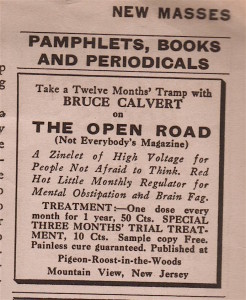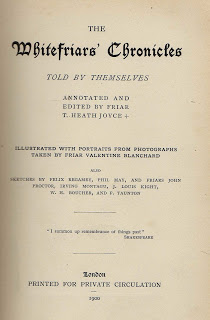 Found in the classified column of The New Masses for May 1927 is this advert for The Open Road, a monthly magazine described by its founding editor, Bruce Calvert, as ‘A Zinelet of High Voltage for People Not Afraid to Think’ and a cure for ‘ Mental Obstipation and Brain Fag ‘.
Found in the classified column of The New Masses for May 1927 is this advert for The Open Road, a monthly magazine described by its founding editor, Bruce Calvert, as ‘A Zinelet of High Voltage for People Not Afraid to Think’ and a cure for ‘ Mental Obstipation and Brain Fag ‘.
Calvert, who ran the operation from his home in Pequannock , New Jersey, delightfully dubbed by him ‘Pigeon-Roost-in-the Woods’, had been a hard-bitten magazine editor in Chicago and Pennsylvania before moving to the backwoods of Griffiths, near Gary, in his home state of Indiana, to take up the life of an anarchist-freethinker inspired by, among others, Walt Whitman and Thoreau. In 1908 he had brought out the first issue of The Open Road, which appeared regularly until 1915. Espousing a philosophy of ‘right thinking and right living ‘, Calvert made his magazine a fount of various heterodoxies which delighted in offending straight-laced home-loving and family-orientated Americans. In April 1911 one of the most controversial issues challenged the hijacking of Christmas by commerce—a point of view which earned him the soubriquet of ‘Indiana’s Prize Crank ‘.
By November 1911 ‘The World League for a Sane Christmas’ had established its HQ in Room 431 of the State Life Building in downtown Indianapolis. Members who paid their $10 subscription could expect their money to go towards various planned publications as well as a booklet entitled The Christmas Insanity. Moreover, each new member was obliged to sign the following agreement:
‘I will from this time forward neither give nor accept Christmas presents outside my own immediate household, and I will do all I can by distributing literature and other propaganda work to discourage the senseless practice of indiscriminate Christmas giving, to the end that true human love and brotherhood may reign in the hearts of men instead of the maudlin insanity which now disgraces the day ‘ Continue reading

